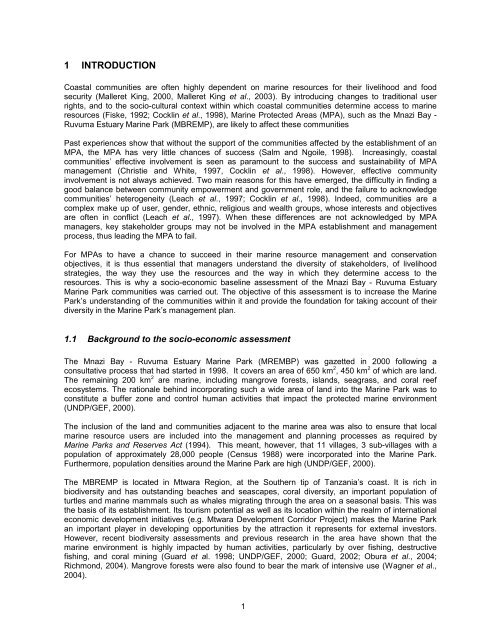a socio-economic baseline assessment of the mnazi bay - IUCN
a socio-economic baseline assessment of the mnazi bay - IUCN
a socio-economic baseline assessment of the mnazi bay - IUCN
You also want an ePaper? Increase the reach of your titles
YUMPU automatically turns print PDFs into web optimized ePapers that Google loves.
1 INTRODUCTION<br />
Coastal communities are <strong>of</strong>ten highly dependent on marine resources for <strong>the</strong>ir livelihood and food<br />
security (Malleret King, 2000, Malleret King et al., 2003). By introducing changes to traditional user<br />
rights, and to <strong>the</strong> <strong>socio</strong>-cultural context within which coastal communities determine access to marine<br />
resources (Fiske, 1992; Cocklin et al., 1998), Marine Protected Areas (MPA), such as <strong>the</strong> Mnazi Bay -<br />
Ruvuma Estuary Marine Park (MBREMP), are likely to affect <strong>the</strong>se communities<br />
Past experiences show that without <strong>the</strong> support <strong>of</strong> <strong>the</strong> communities affected by <strong>the</strong> establishment <strong>of</strong> an<br />
MPA, <strong>the</strong> MPA has very little chances <strong>of</strong> success (Salm and Ngoile, 1998). Increasingly, coastal<br />
communities’ effective involvement is seen as paramount to <strong>the</strong> success and sustainability <strong>of</strong> MPA<br />
management (Christie and White, 1997, Cocklin et al., 1998). However, effective community<br />
involvement is not always achieved. Two main reasons for this have emerged, <strong>the</strong> difficulty in finding a<br />
good balance between community empowerment and government role, and <strong>the</strong> failure to acknowledge<br />
communities’ heterogeneity (Leach et al., 1997; Cocklin et al., 1998). Indeed, communities are a<br />
complex make up <strong>of</strong> user, gender, ethnic, religious and wealth groups, whose interests and objectives<br />
are <strong>of</strong>ten in conflict (Leach et al., 1997). When <strong>the</strong>se differences are not acknowledged by MPA<br />
managers, key stakeholder groups may not be involved in <strong>the</strong> MPA establishment and management<br />
process, thus leading <strong>the</strong> MPA to fail.<br />
For MPAs to have a chance to succeed in <strong>the</strong>ir marine resource management and conservation<br />
objectives, it is thus essential that managers understand <strong>the</strong> diversity <strong>of</strong> stakeholders, <strong>of</strong> livelihood<br />
strategies, <strong>the</strong> way <strong>the</strong>y use <strong>the</strong> resources and <strong>the</strong> way in which <strong>the</strong>y determine access to <strong>the</strong><br />
resources. This is why a <strong>socio</strong>-<strong>economic</strong> <strong>baseline</strong> <strong>assessment</strong> <strong>of</strong> <strong>the</strong> Mnazi Bay - Ruvuma Estuary<br />
Marine Park communities was carried out. The objective <strong>of</strong> this <strong>assessment</strong> is to increase <strong>the</strong> Marine<br />
Park’s understanding <strong>of</strong> <strong>the</strong> communities within it and provide <strong>the</strong> foundation for taking account <strong>of</strong> <strong>the</strong>ir<br />
diversity in <strong>the</strong> Marine Park’s management plan.<br />
1.1 Background to <strong>the</strong> <strong>socio</strong>-<strong>economic</strong> <strong>assessment</strong><br />
The Mnazi Bay - Ruvuma Estuary Marine Park (MREMBP) was gazetted in 2000 following a<br />
consultative process that had started in 1998. It covers an area <strong>of</strong> 650 km 2 , 450 km 2 <strong>of</strong> which are land.<br />
The remaining 200 km 2 are marine, including mangrove forests, islands, seagrass, and coral reef<br />
ecosystems. The rationale behind incorporating such a wide area <strong>of</strong> land into <strong>the</strong> Marine Park was to<br />
constitute a buffer zone and control human activities that impact <strong>the</strong> protected marine environment<br />
(UNDP/GEF, 2000).<br />
The inclusion <strong>of</strong> <strong>the</strong> land and communities adjacent to <strong>the</strong> marine area was also to ensure that local<br />
marine resource users are included into <strong>the</strong> management and planning processes as required by<br />
Marine Parks and Reserves Act (1994). This meant, however, that 11 villages, 3 sub-villages with a<br />
population <strong>of</strong> approximately 28,000 people (Census 1988) were incorporated into <strong>the</strong> Marine Park.<br />
Fur<strong>the</strong>rmore, population densities around <strong>the</strong> Marine Park are high (UNDP/GEF, 2000).<br />
The MBREMP is located in Mtwara Region, at <strong>the</strong> Sou<strong>the</strong>rn tip <strong>of</strong> Tanzania’s coast. It is rich in<br />
biodiversity and has outstanding beaches and seascapes, coral diversity, an important population <strong>of</strong><br />
turtles and marine mammals such as whales migrating through <strong>the</strong> area on a seasonal basis. This was<br />
<strong>the</strong> basis <strong>of</strong> its establishment. Its tourism potential as well as its location within <strong>the</strong> realm <strong>of</strong> international<br />
<strong>economic</strong> development initiatives (e.g. Mtwara Development Corridor Project) makes <strong>the</strong> Marine Park<br />
an important player in developing opportunities by <strong>the</strong> attraction it represents for external investors.<br />
However, recent biodiversity <strong>assessment</strong>s and previous research in <strong>the</strong> area have shown that <strong>the</strong><br />
marine environment is highly impacted by human activities, particularly by over fishing, destructive<br />
fishing, and coral mining (Guard et al. 1998; UNDP/GEF, 2000; Guard, 2002; Obura et al., 2004;<br />
Richmond, 2004). Mangrove forests were also found to bear <strong>the</strong> mark <strong>of</strong> intensive use (Wagner et al.,<br />
2004).<br />
1
















